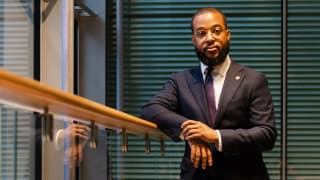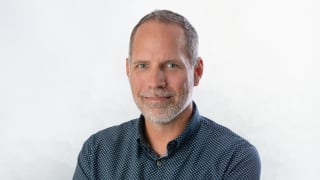Ushering in the digital age of tourism
There’s a lot of noise about digital transformation in the destination marketing and investment promotion space. But what’s less clear is how these big concepts will actually manifest themselves. In Helsingborg, however, they’re actually walking the walk and they became one of the first major cities in Europe to close their tourist information centres. Emma Håkansson, Head of Destination Development for the City of Helsingborg, Sweden, joined us to explain how they transitioned from brick and mortar establishments to a digital-first approach.
There’s a fantastic interview with the Mayor of Helsingborg, Peter Danielsson, on Helsingborg’s goal to becoming one of Europe’s most innovative cities by 2022. It’s clear that you have a lot of different initiatives that work towards this – and of course, there’s the H22 Smarter City Expo. Is this all part of the same philosophy of becoming a more digital city?
It is, for sure. We have a very progressive Mayor and politics here and it’s all about trying out new ways to improve our service for the people that live here and visit us. The H22 Smart City Expo is going to be a huge thing for us and our town - we’re really looking forward to it, it’s a very cool initiative from the city.
It sounds it. So, what is it exactly? Would you be able to share a little more information about how the Smart City Expo came about?
We have a lot of history of Expos– we’ve had Housing Expos, and Design Expos that are well known in Sweden. We first had the Helsingborg Exhibition in 1955, and then the Housing Expo in 1999, but we wanted to take the next step to make it a Smart City Expo - a city exhibition. We put about 250 million krona (which is about 25 million euros) into innovation and sustainable solutions – both in housing, and also in how the municipality works. Half of the money goes into our own organisation - how are we going to be smarter when we have fewer people who are making taxes? – and the other half goes into working together with local and national stakeholders and also global companies. We've invited a number of big companies like Google, and we're exciting to already be working with a organisations like IBM and IKEA already. We tried to see how we could make smart cities solution together with other stakeholders as well.
The innovation isn’t all technology driven, but of course a lot of it is. And the goal is to talk about the sustainable life between the houses. That’s not only how we build the city but also the city governance. How will the mayor and organisation work in the future? We’re going to invite people from all over the world for talks here, but we’re also inviting companies to try out Helsingborg as a testbed.
And that’s not just a marketing phrase either is it? In many ways, you use Helsingborg as a testing bed internally, for example being the first Swedish city to close your tourist information centres. When did the move to digital solutions happen, and how has that changed the way you work?
It started around 2014. I come from the travel industry, and that’s where we saw the change first. Travel agents started moving to online distribution in the early 2000-and-somethings. Travel agents all over Sweden closed down. You have to look at which channels your customers use and how you optimise your offer. I think we started around 2014 with a really good analysis of what channels visitors actually use, and how many visitors actually come to the tourist information centres, and how many of them use our home page – and are they relevant with the way that people actually contact us? The more we dug into this, we realised that almost 99% of visitors to the city never contacted us at all. They were never in touch with us. That was where it started. Along the way, we found so many other things, but it took some time and some convincing of people. It wasn’t until 2016 that we actually closed the tourist information centres and went into trying to find the customers through different channels. And also working with the local industry to make sure they were the best ambassadors that they could be – they took a lot of the service towards the guests instead of us. It took some convincing along the way, but the strategy was that we want to be on the platforms that our customers are on.
Still, it was bold move at the time to go digital-first.
For us, it wasn’t a choice of going digital or not, but more of a strategy to say ‘Okay, maybe we don’t know everything, maybe we’re not in control of the information anymore like we used to be.’ The story used to be that the tourist information centres and the people that worked there knew everything that was worth knowing about in a destination. They were little kingdoms, and you had to see them because they would give you everything. Today, it doesn’t look like that. Mostly, we don’t even know what is going on. We’re not in control of the information anymore.
Our strategy was to provide good service where the customers actually are. That could be in the hotels, that could be on the streets where they’re asking locals questions, that could be Trip Advisor, it could be Google, it could be on a homepage… There are so many other interactions that a visitor uses. Of course, it’s digital technology that makes it possible, but it wasn’t all driven by doing digital. The strategy was to get closer to the tourist, and the visitor and the channels that they use.
And has the fact that you’re using these different channels enabled you to be better listeners to the information that people are asking for?
I think one of the things we noticed is that once they actually do contact us by phone or on Facebook or Messenger, they have very specific questions. They’re questions you can’t find the answers to online. Or if you want a personally created, Fitbit suited programme – like “I have 12 hours – what can’t I miss?” The questions narrowed down to being more about emergency exits or niche guide operators somehow, as opposed to being as general as they used to be.
You said they come to us for what they can’t find on normal Google search and we were speaking at our City Nation Place Latin America & Caribbean conference about how you need to check what people are finding through their usual search activity. An outstanding example is Puerto Rico after the hurricane– if you were googling hotels, Google was still showing images of them devastated by hurricanes, and they had to manage that. Is that an exercise you do? You talk about the very specific stuff that people are interacting with you personally on, but in the wider space, are you looking at what people are finding out about Helsingborg?
Absolutely. Some of the most important channels for us are Google and Trip Advisor. So we work with Google Destinations, and we work with Google Places a lot. And we work with local companies -educating them using Google Academy. How will they be shown on searches? What does it look like when you search for shopping Helsingborg? What do you see when you search for beaches? The official places like shopping streets or play parks or beaches… no one really owns them on Google or Trip Advisor. We started actually claiming about 60-70 different places in the city, and saying, we own these places. It gave us more control over what photos are shown for those places. And once you claim them, people can start referring them, and rating them, and that’s when you start the interaction personally with people. But it all starts with the strategy of ‘how do we look on the platforms people actually use?’
That makes perfect sense. And that’s not just in terms of what visitors are looking for, but also what potential investors and businesses are looking for?
If you want to move here – it’s the same if you’re looking in housing districts or looking for an apartment in the city. It’s the same strategy there.
Was there anything in particular that was challenging about this digital-first shift? Or something that didn’t work as well? It’s a big change after all.
I think the hardest part was actually the locals because it’s such a symbol of tourism, just having this institution where you can send people and it really shows that you work with tourism; it’s the only thing that’s actually visible. Of everything we do, whether it’s marketing campaigns abroad or big investors – the locals never really see that, but they did see the tourist information centres and that was their only pride somehow. Citizens were proud to work in tourism, it’s important to them, they want to be a good tourist destination. That was the hardest part. We had a communication strategy that was down to almost the hour by the end. The hardest job was to convince and to explain our strategy to the locals, because they only saw that we closed down, they didn’t see that we were still putting as much money into tourism.
The perception was that you were reducing budgets?
It was hard. I’ve never been that much in local media. There were so many people who looked me up on Facebook and wrote to me. It was quite hard for a few months. Helsingborg is not big – we have approximately 150,000 inhabitants – but still I was in the newspaper every week. Everyone knew my name and thought, “Oh, she’s the person who closed down the tourist information centres.” So that was quite tough. We were the first place in Sweden to close down the tourist information centres, so there was a lot of negative feelings around the industry in Sweden as well. But now, Stockholm have just announced that they’re closing their tourist centres. It’s a bit of a trend now, but it wasn’t that easy in the beginning.
Were they any particular lessons that you learned during the process of reinventing Helsingborg as a digital city?
Of course things went wrong, and there are thing that we’ve stopped doing. I mean, we had to try out different ways to give visitor services back. We started welcome meetings at the big campgrounds, and the bigger hotels – and we’ve stopped doing them because people didn’t come to them. And we’ve put a lot of money in to making digital touchpoints in the city where you could see on Google Maps where you have all the attractions, how to get there, the opening hours… everything. We out so much money into this software and this digital signage, and no one really uses them. But maybe it’s a good thing. You have to make digital things visible somehow, so maybe it was useful to show that okay, we still offer services – we’ve just gone online.
I think knowing what I know today, some of the things maybe I wouldn’t have done, but I don’t regret closing the tourist information centres. I think the progression that we’ve done in adding value to visitors and meeting them in the channels that they’re actually in easily outweighs it. Plus working with the tourism industry and the local businesses has bought us a lot closer to them as well, which is a very good sign.
One of the really positive things that came out of it, is that we became a member of the International Greeters Association. We have locals who meet up with visitors so they can do guided tours of the city and show them their hot spots. It’s all visitors want these days – to live like a local. So in the end, it did turn out to be good for local engagement. And they’re active because they want to be a tourist destination.
Amazing. I’d not heard of the International Greets Association before. That sounds fascinating!
It’s really cool! I think it started in New York, but there are lots of cities into it now, and the people who book a local greeter aren’t allowed to pay them anything, so they’re not in competition with local tour guide companies. Some of the best greeters we have now have friends all over the world. They can visit friends in Guatemala or the UK, and they’ll send postcards to each other. For us, it’s a small thing. We don’t put much money or time into it, but it’s a really nice way for people to interact.
Just jumping back quickly to your digital-first approach – how do you measure success and return on where you’re now investing?
One of the key indicators we use is Cost Per Contact. So we measure and look into what it cost us when we had a tourist information centre, and all of the channels that we owned and managed. And then the cost per contact operating without a tourist centre. We also do an annual net promoter score, and we ask the visitors how happy they are with Helsingborg as a destination, and whether they’d recommend it to anyone else. Then together with Lund University, we did a study last summer on how visitors found tourist information in the city, how they researched the city before they came, what their interaction was with local business… so we have a qualitative analysis of that as well.
We try to follow-up. I mean, we can’t measure everything all the time, but for us, it was important to see not just the cost, but also how happy the guests are.
And obviously it’s key that there hasn’t been a drop off in tourism since you got rid of the tourist information centre!
Exactly! We’re still tracking the number of guest nights and number of tourists annually. And there hasn’t been any drop off at all. And one good measurement is that we still have phone, and email and social media and all those channels. And not one single time – not once - have we had a message from a tourist asking where the tourist information centre is, or saying they’re disappointed that we don’t have a tourist information centre. Not one.
Tourist Information Centres are a big investment and you probably spent a lot of time proving that you need it to everyone around you, so it’s probably one of the hardest thing to actually cut off. And it’s visible – if you can’t show what you do otherwise, then you’re probably in trouble as a DMO.
And finally, did you look to any other places to see what they were doing and how they were doing it?
We looked into a lot of places, but we also looked into other businesses. I think we could learn a lot from looking at how the general customer is and how they’re behaving. We looked at online travel agents, of course, but also the retail industry and what’s happening there with online shopping and online services. We’ve had a wave of post offices, bank offices and other institutions like that closing down, and so we examined how they address this, and how are they working with their customers. We looked at a lot of businesses and then picked the best pieces of everyone, so we haven’t really followed one certain destination or one certain company, just picked the best ideas from everyone.
Thank you very much for speaking with us, Emma.
Interested in learning more? Check out our latest place branding articles.










